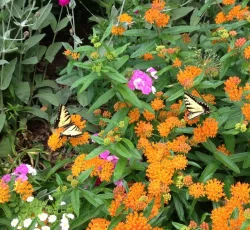
Basket of Gold
Aurinia saxatilis
These sweet-smelling golden flowers are ideal for the front of the border in spring when bulbs are blooming.
EXPLORE THIS PLANT
These sweet-smelling golden flowers are ideal for the front of the border in spring when bulbs are blooming.
EXPLORE THIS PLANT
A cottage garden favorite, black-eyed susan features masses of ferociously yellow flowers that attract butterflies. They are incredibly hardy and tolerate a wide variety of conditions, making them ideal for naturalizing.
EXPLORE THIS PLANT
This unique plant features bright blue-purple flowers on tall green stalks followed by interesting black seedpods. It forms a deep taproot and does not transplant well, so be certain of its location before planting.
EXPLORE THIS PLANT
This plant features brilliant orange flowers that light up the garden and are attractive to pollinators, including monarchs and honeybees.
EXPLORE THIS PLANT
Spires of pink and white bracts crown this large-leafed salvia. It has been used as an herb since the Middle Ages and is currently used as flavoring for wines, vermouth, and liqueurs.
EXPLORE THIS PLANT
Fragrant spires of dark purple flowers above silvery foliage light up the garden border in summer. If trimmed after blooming, they will flower again. Their flowers may be used in sachets or as flavoring in baking and drinks.
EXPLORE THIS PLANT
An unusual flower for the summer garden, these blue thistle-like blooms add a unique texture. If cut back after blooming, they will send up new flowers. They make excellent dried and cut flowers.
EXPLORE THIS PLANT
This versatile hydrangea tolerates a wide variety of conditions and is ideal for borders or natural areas. It benefits from an annual pruning in late winter to prevent the heavy blooms from flopping.
EXPLORE THIS PLANT
Jerusalem artichoke is a perennial sunflower relative that produces a profusion of bright yellow flowers atop ten foot stalks. It is valued for its edible tubers, which resemble the flavor of water chestnuts.
EXPLORE THIS PLANT
This silver-leafed groundcover does best in well-drained soil, but tolerates adverse conditions. Its purple flowers are attractive to honeybees and bumblebees.
EXPLORE THIS PLANT